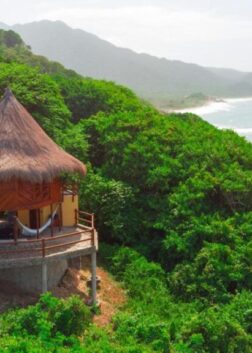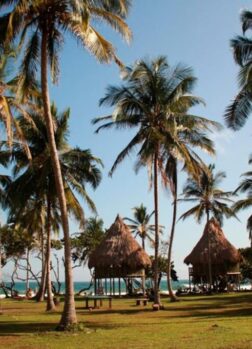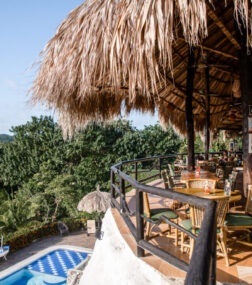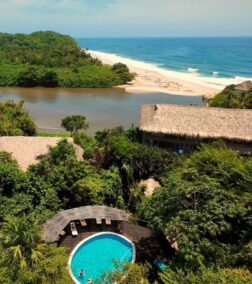How to visit Tayrona National Park in Colombia

Entrance Fees and Park Hours
Two entrances:
You’ll also need to pay mandatory park insurance at the entrance, which costs 6,000 COP/1,50 USD. Additionally, you can pay for camping and accommodation at the gate.
Tayrona closes for several week each year
Tayrona National Park is one of the most popular destinations in Colombia, but it’s also a religious site for various indigenous tribes.Three times a year the park closes for two weeks. The tribes can then perform their rituals in piece and the trails a chance to recover from tourism.
Closing dates Tayrona 2024
- 1 februari t/m 15 februari
- 1 juni t/m 15 juni
- 19 oktober t/m 2 november
Bus from El Zaino entrance
You can skip the first and also the most boring part of the hike. From the entrance to the start of the trail is a ‘normal’ road and it takes 1 hour to walk this part. The bus is only 5000 COP/€1, for a single trip so it’s well worth it. You pay cash to the driver. The drive takes around 10 minutes.
Extra tips: You can pay with card (some blogs mention that it’s only cash.) They do need your passport details, but a copy/photo on your phone is sufficient
What to do in Tayrona
There’s a few ways to enjoy Tayrona National park. That is by hiking, seeing the wildlife and relaxing on the beach.

Hiking options in Tayrona
There are two main hikes. The one from the Main entrance to Cabo San Juan is the hike that the majority of visitors will do. This route takes around 2 hours and you’ll hike through jungle and stop at several beautiful beaches. It’s the most accessible route and it takes you past the most impressive spot in Tayrona. If you only have 1 or 2 days, I’d recommend starting here.
You can walk to Cabo San Juan and back or you can choose to camp in the park for a night. Camping gives you the opportunity to see the sunset and sunrise in the park, but it’s less comfortable than some of the beautiful lodges just outside. The chance of seeing wildlife is also much bigger in the morning, so that could be another reason to spend a night in the park.
If you have an extra day, you may consider continuing from Cabo San Juan to Playa Brava. This is a rougher 3 hour route that will take you to a more remote part of Tayrona. From Cabo San Juan you start hiking to El Pueblito. This part is mostly ascending! From there you continue for one more hour to Playa Brava. There’s only one available place to stay and that is Ecolodge Playa Brava Teyumakke. Make sure to book in advance. The next day, hiking from Playa Brava to the Calabazo exit will take you 2,5 hours.
The Beaches in Tayrona National Park
- Cabo San Juan: This is the most popular beach, as its the end of the main hike. It’s very picturesque and suitable for swimming. It’s one of the main camping spots. You can book a tent or hammock here.
- Playa Brava: This beach is also an excellent spot to camp (enter this beach from the Calabazo entrance). It a little bit wilder and more remote. Since the sea here is quite rough, there is no swimming here.
- Arrecifes: You can’t swim here, because of the undercurrent, but it’s a gorgeous place to visit nonetheless.
- La Piscina: The name of this beach means ‘swimming pool’ as there are rocks surrounding it, making it look like a saltwater pool (which is also safe for swimming!).
- Playa Cristal: The beach with the clearest, most beautiful water and the perfect place for snorkeling and swimming! Generally, you’ll only get to this beach on a snorkeling tour by boat.
Wildlife and Nature in Tayrona
The park’s lush rainforests, mangroves, and pristine beaches create a rich habitat for an astonishing variety of wildlife. Visitors can spot howler monkeys swinging through the canopy, white-headed capuchins, and the elusive jaguar prowling deep within the jungle. Birdwatchers are treated to over 300 species, including the iconic Andean condor and vibrant toucans. The park’s marine life is equally impressive, with coral reefs teeming with tropical fish, sea turtles, and occasionally dolphins gliding through the turquoise waters
The best time to visit Tayrona National Park
The best time to visit Tayrona depends on your preference. During the rainy season:April/May and September-November you can expect rain showers, but this will be when the park is the most quiet. December, January, June and July are the holiday months and many Colombians will be visiting the park. A good compromise is visiting in March, with only a slight chance of rain and outside of holiday season.
Getting to Tayrona National Park
Santa Marta to Tayrona: Take either a bus or private transfer to Tayrona National Park. If you are arriving at the Santa Marta airport, you will need to get to the bus terminal or market area. The buses to Tayrona Park leave about every 30 minutes from Calle 11 & Carrera 11 in the Central Market.
Walking: If you’re staying in one of the lodges, just outside the park you can walk to the entrance or catch the bus by the side of the road.
Outside the Park:
I wouldn’t recommend sleeping in Santa Martha, because I think it’s just a little too far out. You won’t get to the park early enough to avoid the crowds. However, there are several really nice accommodation just outside the park. From there you can just walk to the entrance or catch a bus. I personally stayed in Quetzal Dorado Eco Lodge and it was wonderful!










